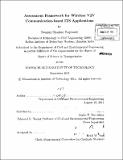Assessment framework for wireless V2V communication-based ITS applications
Author(s)
Rajiwade, Swapnil Shankar
DownloadFull printable version (7.175Mb)
Alternative title
Assessment framework for wireless Vehicle-to-Vehicle communication-based Intelligent Transportation Systems applications
Other Contributors
Massachusetts Institute of Technology. Dept. of Civil and Environmental Engineering.
Advisor
Moshe E. Ben-Akiva.
Terms of use
Metadata
Show full item recordAbstract
Inter-vehicle communication enabled by wireless technology is an emerging area of Intelligent Transportation Systems (ITS). This technology has generated great interest among automobile manufacturers and ITS researchers alike because of its potential to improve safety and non-safety ITS applications by supporting data collection and dissemination at the individual vehicle level. A modelling framework based on a microscopic traffic simulator is presented in this thesis to explore the effects of wireless Vehicle-to-Vehicle (V2V) communication based ITS applications on traffic performance. Microscopic traffic simulators describe the interaction between drivers and infrastructure at individual vehicle level. The behaviour models in microscopic traffic simulators describe driving decisions like route choice, car-following and lane-changing. The existing behaviour model is extended to incorporate the effect of V2V communication based applications by tying information generated by the application to the behaviour model. A case study on a road network in Singapore with green light prediction application as the V2V communication application is implemented. The car-following model in MITSIMLab is modified to account for speed advisories generated by green light prediction application. The application shows gains in travel time savings and a smoother traffic flow as a result of the green light prediction. Higher improvements across penetration rates were observed at high demand levels. The incremental impact of the application on traffic performance tapers off at higher penetration rates. Drivers responding to the speed advisories also affect vehicles immediately following them. Hence the effective penetration rate of the application is higher than actual penetration rate. The results imply that the green light prediction application would reduce the average number of halts per trip by approximately 10% at existing travel demand. The current model can be extended to test other V2V based ITS applications and to couple with a wireless network simulator to represent wireless data flows more realistically.
Description
Thesis (S.M.)--Massachusetts Institute of Technology, Dept. of Civil and Environmental Engineering, 2011. Cataloged from PDF version of thesis. Includes bibliographical references (p. 87-91).
Date issued
2011Department
Massachusetts Institute of Technology. Department of Civil and Environmental EngineeringPublisher
Massachusetts Institute of Technology
Keywords
Civil and Environmental Engineering.